Inside a growing number of homes in the developing world, sand and biological organisms are collaborating to decontaminate drinking water.
Arranged in barrels of concrete or plastic, these biosand water filtration systems (BSFs) remove 95 to 99 percent of the bacteria, viruses, worms and particles contained in rain or surface water. A layer of microorganisms at the top of the sand bed consumes biological and other organic contaminants, while the sand below removes contaminants that cause cloudiness and odor.
A BSF can produce several dozen liters of clean water in an hour. But it can weigh several hundred pounds and cost up to $30, an expense some families in developing countries cannot afford.
Kristen Jellison and her students are trying to build a BSF that is smaller than the standard system, but just as effective.
“Smaller, lighter BSFs,” says Jellison, an associate professor of civil and environmental engineering, “would be cheaper, easier to transport and available to a broader global market. Preliminary research has shown the potential for smaller systems to remove most disease-causing organisms, except possibly viruses.”
Jellison has devoted most of her career to improving drinking water. As coadviser to Lehigh’s chapter of Engineers Without Borders, she helped lead efforts to design and build a 20,000-gallon water-storage tank and chlorination system in Pueblo Nuevo, Honduras.
With support from NSF and the Philadelphia Water Department, she has spent five years studying the parasite Cryptosporidium parvum and its transport and fate in water bodies. The parasite is found in multiple hosts, is difficult to eradicate, and can be deadly to people with compromised immune systems. In an effort to identify possible sources of Cryptosporidium contamination in the Philadelphia watershed, Jellison studies the DNA of various species using a technique called polymerase chain reaction (PCR). She also studies the impact on Cryptosporidium of biofilms, the slimy layers of microorganisms that form on rocks, pipes and other surfaces in water.
Jellison’s group is conducting experiments on BSFs of various sizes, including systems that fit inside two- and five-gallon plastic pails. (The typical BSF is 3 feet high.) The group will change the depth of the sand column, add rusty nails to several pails (in an effort to increase virus removal), and alter other parameters.
“BSFs were developed in the 1980s,” says Jellison. “This is the most comprehensive study to date to characterize the efficiency of different filter types.”

